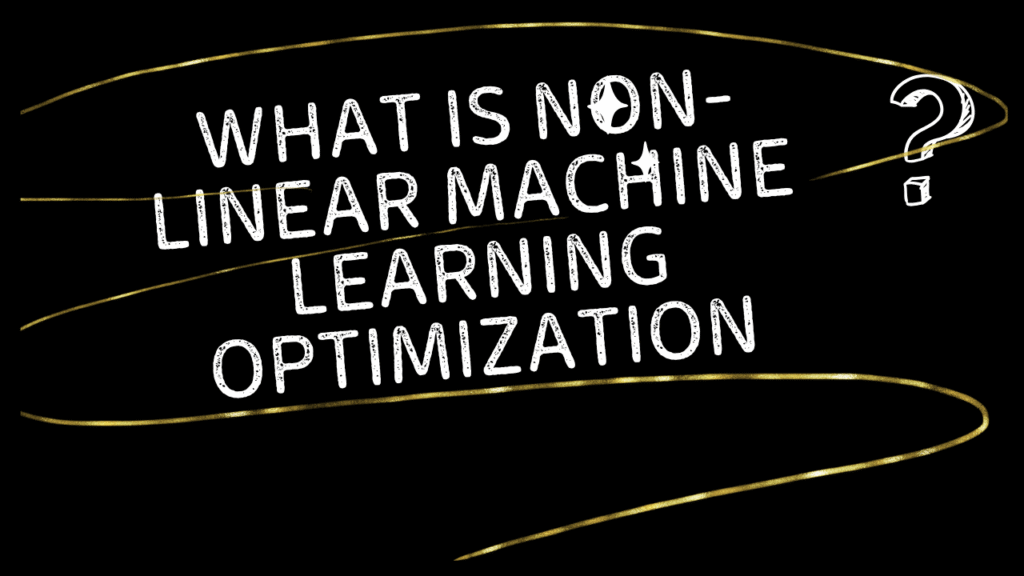Of course! Here’s a detailed and unique blog post on the topic “What is Non-Linear Machine Learning Optimization?”:
Non-Linear Machine Learning Optimization: Cracking the Code Behind Smarter Models
When you hear the word optimization in machine learning, you might immediately think about “making things better” — and that’s true!
But when models get more powerful, flexible, and non-linear, optimizing them becomes much trickier — and far more interesting.
In this blog, we’ll walk through the fascinating world of non-linear machine learning optimization, demystifying what it really means, why it’s important, and how it’s shaping the future of smart technologies.
First Things First: What is Optimization in Machine Learning?
Optimization simply refers to the process of tuning the model so that it performs its best — typically by minimizing error or maximizing accuracy.
During training, machine learning models adjust their internal parameters (like weights in neural networks) to find the “best” version of themselves.
The tool that guides this adjustment is called an optimizer, and its goal is to find the lowest point in a “loss landscape” — a 3D shape where the height represents how wrong the model is.
So, What Does Non-Linear Mean Here?
In simple words:
A system is non-linear when changes in input don’t cause proportional or predictable changes in output.
In machine learning:
- Linear optimization is like finding the straight line that fits data best (think: simple regression).
- Non-linear optimization deals with curved, complex, unpredictable relationships between variables.
Real-world data is messy and complicated — very few real problems are neatly linear. Hence, non-linear models (like deep neural networks, decision trees, SVMs with kernels, etc.) are used to capture those intricate patterns.
Optimizing these non-linear models? That’s the real challenge.
Why Non-Linear Optimization is Harder (But Necessary)
Non-linear models don’t have smooth, bowl-shaped loss surfaces. Instead, their landscapes are:
- Full of hills, valleys, and plateaus
- Non-convex, meaning there are multiple local minima (not just one global minimum)
- Sometimes chaotic, with small parameter changes causing big output shifts
Because of this, optimization algorithms can’t just “walk downhill” easily.
They might:
- Get stuck in local minima (a valley that isn’t the lowest point overall)
- Wander endlessly on flat plateaus
- Oscillate around saddle points (like sitting on a mountain pass — not up, not down)
Thus, smart techniques are needed to navigate this complicated landscape.
Common Techniques for Non-Linear Optimization
Here are some of the star players helping machine learning models optimize themselves even when the going gets rough:
1. Gradient Descent and Its Variants
- Gradient Descent follows the slope of the loss function to reach a low point.
- But basic gradient descent can struggle, so we have:
- Stochastic Gradient Descent (SGD): Introduces randomness, making it less likely to get stuck.
- Momentum: Helps build speed and overcome small bumps.
- Adam Optimizer: Combines ideas from Momentum and Adaptive Learning Rates for faster, smarter optimization.
2. Second-Order Methods
- Methods like Newton’s Method use second derivatives (curvature information) to find better paths.
- Powerful, but computationally expensive for very large models.
3. Evolutionary Algorithms
- Inspired by natural selection — models “evolve” better solutions over generations.
- Used when gradients are unavailable or unreliable.
4. Simulated Annealing
- Like slowly cooling down a material to settle into a low-energy state.
- Introduces controlled randomness to escape local minima.
Where You See Non-Linear Optimization in Action
Deep Learning:
Training deep neural networks to recognize cats in photos? Non-linear optimization.
Each layer’s neurons interact in complex ways.
Reinforcement Learning:
Training a robot to walk or an AI to play chess? Non-linear rewards and strategies must be optimized.
Natural Language Processing (NLP):
Models like GPT (yes, me!) rely on non-linear optimization across billions of parameters.
Computer Vision:
Recognizing faces, detecting cancer cells, or even creating deepfakes involves optimizing very complex, non-linear models.
Real-World Analogy: Hiking in a Foggy Mountain Range
Imagine you’re dropped into a foggy mountain range.
Your mission: Find the deepest valley.
- You can only feel the ground beneath your feet (you can’t see far).
- Sometimes, you think you’re going downhill, but end up on a small pit (local minimum).
- Sometimes, the ground is flat and boring for hours (plateau).
- You have to smartly explore, sometimes taking risky moves to find truly deep valleys.
That’s non-linear optimization in machine learning!
Final Thoughts
Non-linear machine learning optimization is challenging but critical.
Without it, our models would be blind to the richness and messiness of real-world data.
Thanks to smarter optimizers, clever algorithms, and sheer computational power, we can train machines to tackle problems as unpredictable and intricate as life itself.
So next time your model finally starts giving great results after a long training session, remember:
It just navigated a foggy mountain full of cliffs, valleys, and mirages — and emerged victorious. 🏔️🎯
